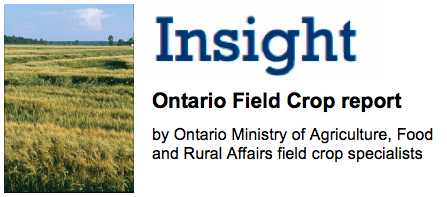Corn: Greg Stewart
Some corn planting has occurred in parts of the province since mid-March, but mostly small acreages.
A risk to ultra early planting is cold shock to the seed/seedling from snow or low temperatures. Most of the corn planted to date seems to have escaped any significant low temperature stress.
Early corn planting (before April 25) does not often out yield corn planted in the April 25 to May 10 window but it does reduce the risk of delayed planting and lower yields if weather conditions turn rainy in the optimum window. Producers are warned that supplies of hybrids is low and replant
options may be limited if early planted corn gets taken out by frost. Early planting of corn should be restricted to only a portion of a producer’s intended acres. Early planted corn under cool conditions can take a significant amount of time to emerge, exposing the seed and young seedling to extended disease and insect pressure.
Hybrid testing in Ontario generally supports the concept of selecting longer season (potentially higher yielding) hybrids when early planting options are available, although efforts to do this may be restricted by tight seed supplies of elite hybrids.
The other risk of ultra early planting is that the growing point may be above the soil surface and exposed to killing frosts that might come in late May or early June. For example, corn planted April 12 might have its growing point above the soil surface and be killed by a frost on May 28, while corn planted May 1 might still have its growing point below the soil surface on May 28 and survive the frost. Environment Canada’s extended forecast for April, May and June is for above average temperatures for all of the corn growing regions of Ontario.
Cereals: Peter Johnson
Winter survival was excellent, with most areas near 100% survival. Heavy clay soil areas are the exception, with few acres planted and up to 50% crop loss due to late planting and excessive moisture. It’s all about drainage and planting date! Frost on March 30th has made winter cereals look tough! Continued cold nights after the frost, dry soil and desiccating winds have prevented the crop from rebounding. A shower and a few warm days will snap the crop out of the current doldrums.
Most nitrogen has been applied. Where weed pressure remains low, delay herbicide applications planned with fungicides until GS 32 to maximize the fungicide value.
Spring cereal acres have rebounded with the early planting conditions. Some acreage has been planted south of normal production regions, where straw supply is desperately short. The majority of the crop is seeded, and stands are emerging nicely. Early seeded stands had early growth frozen off, but are rebounding well. Target weed control at the 3 leaf cereals stage if weeds have emerged.
Canola: Brian Hall
Less than 5% of canola has been planted to date. Ontario does not experience the consistent yield advantage of early seeding observed in Western Canada. Planting into good soil conditions is more important than seeding date aiming for a soil temperature above 10°C, but at least 5°C as a starting point. Newly emerged seedlings can withstand a light frost (0 to -2°C) and can withstand colder temperatures once ‘hardened’ off by several cold days. Let soil conditions and the 5-7 day weather forecast be your guide. Refer to http://bit.ly/omafracanola1 for additional information on canola
seeding.
Cool conditions will slow emergence and early growth, so seed treatments may run out for controlling flea beetles before reaching the 4th leaf stage when plants are large enough to handle feeding damage. Scout early planted fields often to watch for feeding damage as the seed treatment protections
declines with time.
Yields will be optimized from applying 15-25 lb/ac (29-50 lb/ac MAP fertilizer) of seed-placed phosphate (P205) even on high testing soils. Starter phosphorus will have biggest benefit when seeding early or on low Phosphorus testing soils.
Forages: Joel Bagg
Alfalfa broke dormancy exceptionally early in early to mid-March. Significant growth, up to 20 cm, was reported before it was frozen back. Frost damaged alfalfa plants usually recover from the crown or axillary buds.
Winterkill and heaving are reported across the province, especially eastern Ontario. Heavier soils with poor drainage, older stands and fall harvested fields appear to be hardest hit.
Alfalfa fields should be scouted for winterkill, frost damage, and heaving. Fields that showed signs of disease last year but were kept and fields that are slow to green-up this spring should be a priority for monitoring. Using a shovel, dig alfalfa roots, rinse the soil off in a pail, and use a knife to cut open the root and crown. Look for crown and root rots, brownish disclouration and spongy texture. A lack of secondary roots and nodulation are additional symptoms to look for.
Plant health is often more significant than plant density to a successful yield. The minimum number of healthy plants per square foot should be 12-20, 8-12 and 5 plants/sq. foot for 1st, 2nd and 3rd year stands respectively.
Survival of alfalfa plants damaged by heaving will depend on whether the tap root is broken. If the crowns are heaved more than than 2.5 cm (1 in), the taproot is likely broken and the stand may not be salvageable. Refer to “Alfalfa Stand Assessment” (http://bit.ly/omafraforage1 ) and “Alfalfa Frost Heaving” (http://bit.ly/omafraforage2 ).
| Attachment | Size |
|---|---|
| 111.09 KB |



